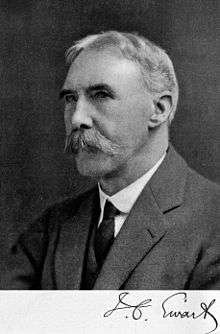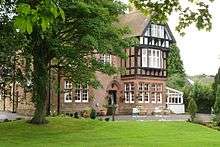James Cossar Ewart

_(14764915404).jpg)

James Cossar Ewart FRS[1] FRSE (26 November 1851 – 31 December 1933) was a Scottish zoologist. He is mainly remembered for his cross-breeding experiments with zebras, creating zebroid, zedonk, Zorse, zonkey and zebrule as "new species", generally known to his local population as Tartan Cuddies.[2]
Life
Ewart was born in Penicuik, Midlothian, Scotland, the son of John Ewart, a joiner, and his wife, Jean Cossar.[3] He studied medicine from 1871 to 1874 at the University of Edinburgh[4] where he graduated MB ChB. After graduation, he became an anatomy demonstrator under William Turner and then held the position of Curator of the Zoological Museum at University College, London, where he was instrumental in establishing the first course of practical zoology. Here he collaborated with Ray Lankester, later director of the Natural History Museum. In 1878 he returned to Scotland to take a post of Professor of Natural History at Aberdeen University from where he moved to Edinburgh University in 1882, staying in the post until 1927.[5]
In 1879 he was elected a Fellow of the Royal Society of Edinburgh. His proposers were Sir William Turner, William Rutherford, William Rutherford Sanders and John Chiene. He won the Society's Neill Prize for 1895-98 and served as their Vice-President 1907 to 1912.[6]
He was elected a Fellow of the Royal Society in June, 1893, having jointly delivered their Croonian Lecture in 1881.
Among various other studies, he performed breeding experiments with horses and zebras, well before the rediscovery of Gregor Mendel's works. Ewart crossed a male zebra with a female pony to show that the theory of telegony inherited from the Greeks was unsound. Telegony held that a female with a history of mating with multiple males would pass on genetic qualities of all previous partners to her offspring. Ewart later bred the mare which had produced zebra-horse hybrids with a pony, and the offspring showed no zebra qualities in either markings or temperament. Ewart's goal was also to produce a draught animal for South African conditions, resistant to African diseases and more tractable than a mule.
In 1883 he commissioned George Washington Browne to design a grand new house in Penicuik, finished in 1885, which is where he died on New Year's Eve 1933/34. It is now the Craigiebield House Hotel.[7]
Family
He married three times, his first wife being the sister of Edward Albert Sharpey-Schafer.
Publications
- The Penycuik Experiments (1899)
References
- ↑ m., F. H. A. (1934). "James Cossar Ewart. 1851-1933". Obituary Notices of Fellows of the Royal Society. 1 (3): 189–195. doi:10.1098/rsbm.1934.0004.
- ↑ http://libraryblogs.is.ed.ac.uk/towardsdolly/2013/02/22/zebra-crossing-james-cossar-ewart-romulus-and-the-penicuik-experiments/
- ↑ "EWART, James Cossar". Who's Who. 59: 570. 1907.
- ↑ a., J. H. (1934). "Prof. J. Cossar Ewart, F.R.S". Nature. 133 (3353): 165–160. doi:10.1038/133165a0.
- ↑ BIOGRAPHICAL INDEX OF FORMER FELLOWS OF THE ROYAL SOCIETY OF EDINBURGH 1783 – 2002 (PDF). The Royal Society of Edinburgh. July 2006. ISBN 0 902 198 84 X.
- ↑ BIOGRAPHICAL INDEX OF FORMER FELLOWS OF THE ROYAL SOCIETY OF EDINBURGH 1783 – 2002 (PDF). The Royal Society of Edinburgh. July 2006. ISBN 0 902 198 84 X.
- ↑ McWilliam, Colin. Buildings of Scotland: Midlothian, p. 384
External links
| Wikimedia Commons has media related to James Cossar Ewart. |
| Wikisource has original works written by or about: James Cossar Ewart |